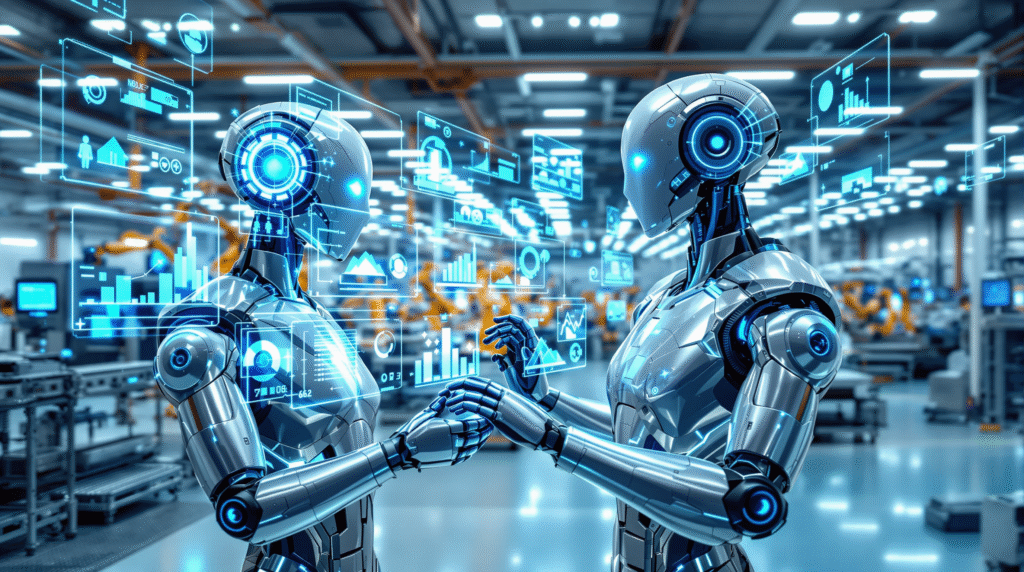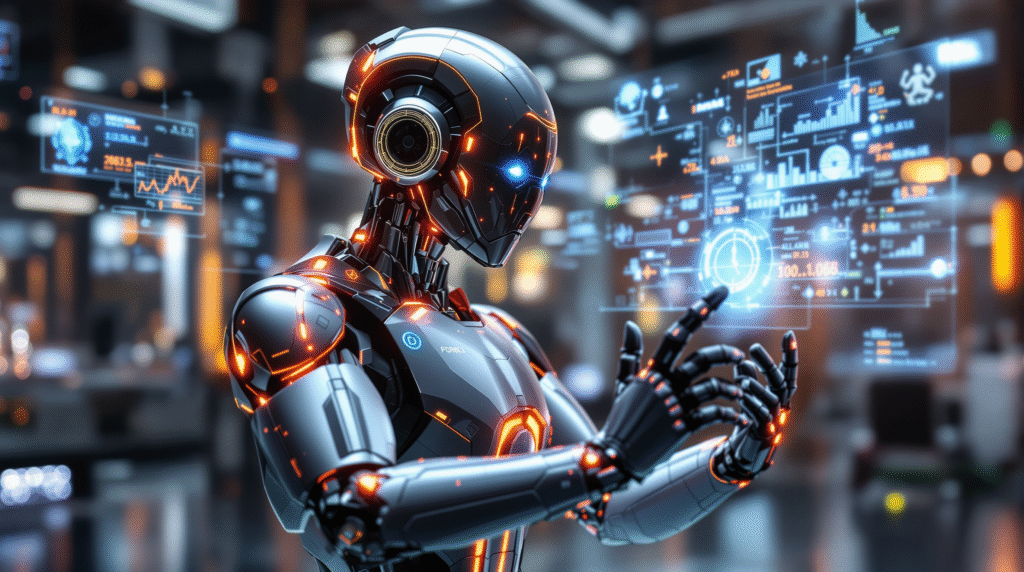Introduction
AI agents are autonomous or semi-autonomous software systems designed to perceive their environment, make decisions, and take actions to achieve specific goals. Unlike traditional software, which follows predefined rules, AI agents leverage machine learning, data analysis, and sometimes reinforcement learning to adapt to changing conditions and optimize their performance over time. In industrial settings, these agents can monitor machinery, manage workflows, and even interact with human operators, making them invaluable for modern manufacturing and logistics.
The Growing Role of AI in Industry
The industrial sector is undergoing a digital transformation, with artificial intelligence at its core. AI agents are increasingly being deployed to address complex challenges such as production bottlenecks, equipment failures, and supply chain disruptions. Their ability to process vast amounts of data in real time allows companies to make faster, more informed decisions, leading to increased efficiency and reduced operational costs.
For example, in manufacturing, AI agents can predict when a machine is likely to fail, schedule maintenance proactively, and optimize production lines for maximum output. In logistics, they can analyze traffic patterns, weather data, and inventory levels to ensure timely deliveries and minimize transportation costs.
The adoption of AI agents is not just a trend but a necessity for companies aiming to stay competitive in a rapidly evolving market. As technology advances, the capabilities of AI agents will continue to expand, driving further innovation and reshaping the future of industry.
Python Example: Simple AI Agent for Predictive Maintenance
Below is a basic Python example that demonstrates how an AI agent might predict equipment failure using a machine learning model:
python
import pandas as pd
from sklearn.ensemble import RandomForestClassifier
from sklearn.model_selection import train_test_split
# Sample data: sensor readings and failure status
data = {
'temperature': [70, 75, 80, 90, 95, 100],
'vibration': [0.2, 0.3, 0.4, 0.6, 0.7, 0.9],
'failure': [0, 0, 0, 1, 1, 1]
}
df = pd.DataFrame(data)
# Features and target
X = df[['temperature', 'vibration']]
y = df['failure']
# Split data
X_train, X_test, y_train, y_test = train_test_split(X, y, test_size=0.2, random_state=42)
# Train model
model = RandomForestClassifier()
model.fit(X_train, y_train)
# Predict failure for new data
new_data = pd.DataFrame({'temperature': [85], 'vibration': [0.5]})
prediction = model.predict(new_data)
print("Predicted failure (1 = Yes, 0 = No):", prediction[0])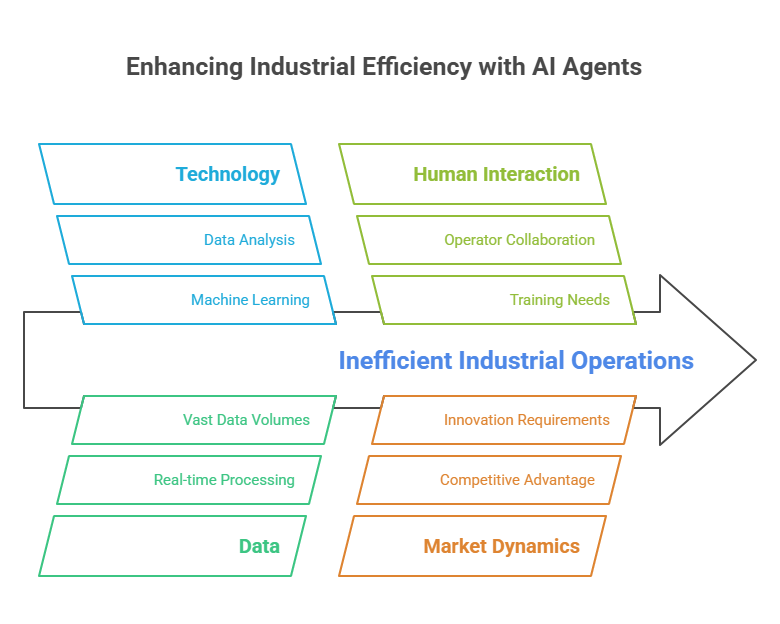
This simple example shows how an AI agent can use sensor data to predict potential equipment failures, helping industries prevent costly downtime.
How AI Agents Work in Industrial Environments
2.1 Key Technologies Behind AI Agents
AI agents in industry rely on a combination of advanced technologies to operate effectively. The foundation is machine learning, which enables agents to learn from historical and real-time data. Algorithms such as neural networks, decision trees, and reinforcement learning allow these agents to recognize patterns, make predictions, and optimize processes.
Another crucial technology is the Internet of Things (IoT). IoT devices, such as sensors and smart machines, continuously collect data from the production floor or logistics chain. This data is then processed by AI agents, providing them with up-to-date information about the environment. Cloud computing and edge computing also play a significant role, offering the computational power needed to analyze large datasets and make decisions in real time.
Natural language processing (NLP) is increasingly used to enable AI agents to communicate with human operators, interpret instructions, and generate reports. Computer vision, powered by deep learning, allows agents to inspect products, monitor equipment, and ensure quality control through image and video analysis.
2.2 Integration with Existing Systems
For AI agents to deliver value, they must integrate seamlessly with existing industrial systems. This often involves connecting to manufacturing execution systems (MES), enterprise resource planning (ERP) platforms, and supervisory control and data acquisition (SCADA) systems. Through APIs and middleware, AI agents can access relevant data, issue commands, and coordinate actions across different parts of the organization.
Integration also requires careful attention to data security and privacy. Industrial environments often handle sensitive information, so robust encryption, access controls, and compliance with industry standards are essential.
A successful integration strategy includes pilot projects, where AI agents are first tested in a controlled environment. This approach allows companies to evaluate performance, identify potential issues, and gradually scale up deployment across the organization.
Python Example: Integrating an AI Agent with Sensor Data
Below is a simple Python example showing how an AI agent might collect and process data from industrial sensors using the pandas library:
python
import pandas as pd
# Simulated sensor data from a production line
sensor_data = {
'timestamp': ['2024-05-15 08:00', '2024-05-15 08:01', '2024-05-15 08:02'],
'temperature': [72, 74, 76],
'vibration': [0.21, 0.23, 0.25]
}
df = pd.DataFrame(sensor_data)
# AI agent processes the data to detect anomalies
def detect_anomaly(row):
if row['temperature'] > 75 or row['vibration'] > 0.24:
return 'Anomaly'
return 'Normal'
df['status'] = df.apply(detect_anomaly, axis=1)
print(df)This example demonstrates how an AI agent can monitor real-time sensor data, detect anomalies, and flag potential issues for further investigation.
3.1 Process Automation and Optimization
AI agents are transforming manufacturing by automating repetitive tasks and optimizing complex processes. Unlike traditional automation, which relies on fixed rules, AI agents can adapt to changing conditions on the production line. They analyze real-time data from machines and sensors, adjusting parameters such as speed, temperature, or material flow to maximize efficiency and minimize waste. This dynamic approach leads to higher productivity, reduced downtime, and better resource utilization.
For example, an AI agent can monitor the entire production process, detect bottlenecks, and automatically reroute tasks to less busy machines. It can also balance workloads, predict maintenance needs, and ensure that production targets are met without overloading equipment.
3.2 Predictive Maintenance
One of the most valuable applications of AI agents in manufacturing is predictive maintenance. Instead of following a fixed maintenance schedule, AI agents analyze sensor data to predict when a machine is likely to fail. By identifying early warning signs—such as unusual vibrations, temperature spikes, or changes in energy consumption—AI agents can alert maintenance teams before a breakdown occurs.
This proactive approach reduces unplanned downtime, extends the lifespan of equipment, and lowers maintenance costs. It also allows manufacturers to schedule repairs during planned shutdowns, minimizing disruption to production.
3.3 Quality Control and Inspection
AI agents equipped with computer vision and machine learning algorithms are revolutionizing quality control. They can inspect products on the production line in real time, identifying defects, inconsistencies, or deviations from specifications. Unlike human inspectors, AI agents do not tire or lose focus, ensuring consistent and objective quality checks.
For instance, an AI agent can analyze images of products to detect surface defects, incorrect assembly, or color mismatches. It can also measure dimensions with high precision, ensuring that every item meets quality standards. When a defect is detected, the agent can automatically remove the faulty product from the line or trigger corrective actions.
Python Example: Simple Quality Control with Computer Vision
Below is a basic Python example using the opencv and numpy libraries to simulate how an AI agent might detect defects in product images. (Note: In a real-world scenario, you would use actual images and more advanced models.)
python
import cv2
import numpy as np
# Simulate loading a grayscale image of a product (as a numpy array)
# In practice, use: img = cv2.imread('product.jpg', cv2.IMREAD_GRAYSCALE)
img = np.random.randint(0, 255, (100, 100), dtype=np.uint8)
# Simulate a defect: a bright spot in the image
img[50:55, 50:55] = 255
# Simple defect detection: find bright spots
def detect_defect(image, threshold=240):
# Find pixels above the threshold
defect_pixels = np.sum(image > threshold)
if defect_pixels > 10:
return "Defect detected"
else:
return "No defect"
result = detect_defect(img)
print(result)This example demonstrates how an AI agent can process image data to detect anomalies or defects, supporting automated quality control in manufacturing.
4.1 Intelligent Supply Chain Management
AI agents are revolutionizing supply chain management by providing real-time insights and automating decision-making processes. These agents can monitor inventory levels, track shipments, and predict demand fluctuations using advanced analytics and machine learning. By analyzing historical sales data, market trends, and external factors such as weather or geopolitical events, AI agents help companies optimize stock levels, reduce shortages, and avoid overstocking.
For example, an AI agent can automatically reorder materials when inventory drops below a certain threshold or suggest alternative suppliers if a disruption is detected. This level of automation ensures a more resilient and responsive supply chain, capable of adapting quickly to changing market conditions.
4.2 Warehouse Automation
In modern warehouses, AI agents play a crucial role in automating and optimizing operations. They coordinate the movement of goods, manage robotic systems, and streamline picking, packing, and shipping processes. By analyzing data from sensors, cameras, and RFID tags, AI agents can track the location of every item in real time, reducing errors and improving efficiency.
AI agents can also optimize warehouse layouts, ensuring that high-demand products are stored in easily accessible locations. This reduces the time needed to fulfill orders and increases overall throughput. In some advanced facilities, AI agents even control fleets of autonomous mobile robots, which transport goods between storage areas and shipping docks without human intervention.
4.3 Route Optimization and Fleet Management
Efficient transportation is essential for successful logistics, and AI agents excel at optimizing delivery routes and managing vehicle fleets. By processing data on traffic conditions, weather, delivery windows, and vehicle status, AI agents can calculate the most efficient routes for each delivery. This minimizes fuel consumption, reduces delivery times, and lowers operational costs.
AI agents can also monitor the health of vehicles, schedule maintenance, and predict potential breakdowns, ensuring that the fleet remains in optimal condition. In addition, they can dynamically reassign deliveries in response to unexpected events, such as traffic jams or vehicle malfunctions, maintaining high service levels and customer satisfaction.
Python Example: Simple Route Optimization Using Dijkstra’s Algorithm
Below is a basic Python example that demonstrates how an AI agent might find the shortest delivery route between warehouses using Dijkstra’s algorithm.
python
import heapq
def dijkstra(graph, start, end):
queue = [(0, start, [])]
seen = set()
while queue:
(cost, node, path) = heapq.heappop(queue)
if node in seen:
continue
path = path + [node]
if node == end:
return (cost, path)
seen.add(node)
for (next_node, weight) in graph.get(node, []):
heapq.heappush(queue, (cost + weight, next_node, path))
return float("inf"), []
# Example graph: nodes are warehouses, edges are travel times
graph = {
'A': [('B', 2), ('C', 5)],
'B': [('C', 1), ('D', 4)],
'C': [('D', 1)],
'D': []
}
cost, path = dijkstra(graph, 'A', 'D')
print(f"Shortest route: {' -> '.join(path)} with total cost: {cost}")This example shows how an AI agent can calculate the most efficient delivery route, supporting smarter logistics and fleet management.
Case Studies: Real-World Applications
5.1 Success Stories from Leading Companies
The adoption of AI agents in manufacturing and logistics is no longer just a theoretical concept—it’s a proven strategy that delivers measurable results. Many leading companies across the globe have successfully implemented AI agents to streamline operations, reduce costs, and gain a competitive edge.
For example, Siemens has integrated AI agents into its manufacturing plants to monitor equipment health and predict failures before they occur. By analyzing sensor data in real time, Siemens’ AI agents can schedule maintenance only when necessary, reducing downtime and extending the lifespan of critical machinery. This predictive maintenance approach has led to significant cost savings and improved operational efficiency.
Another notable case is Amazon, which uses AI agents extensively in its logistics and warehouse operations. Amazon’s AI-powered robots and software agents coordinate the movement of millions of products daily, optimizing storage, picking, and shipping. These agents analyze order patterns, inventory levels, and delivery routes to ensure that products reach customers quickly and efficiently. As a result, Amazon has set new standards for speed and reliability in e-commerce logistics.
5.2 Lessons Learned and Best Practices
The experiences of these industry leaders highlight several best practices for implementing AI agents in industrial environments. First, it’s essential to start with a clear business objective—whether it’s reducing downtime, improving quality, or optimizing logistics. Pilot projects are a valuable way to test AI agents in a controlled setting, gather feedback, and refine the solution before scaling up.
Another key lesson is the importance of data quality. AI agents rely on accurate, timely data from sensors, machines, and business systems. Investing in robust data infrastructure and ensuring seamless integration with existing platforms is crucial for success.
Change management is also vital. Employees should be involved early in the process, with training and support to help them adapt to new technologies. Companies that foster a culture of innovation and continuous improvement are better positioned to realize the full benefits of AI agents.
Python Example: Simulating Predictive Maintenance ROI
Below is a simple Python example that estimates the return on investment (ROI) from implementing predictive maintenance with AI agents, based on reduced downtime and maintenance costs.
python
# Example data: costs before and after AI implementation
downtime_hours_before = 100
downtime_hours_after = 40
cost_per_hour = 1000
maintenance_cost_before = 50000
maintenance_cost_after = 35000
# Calculate savings
downtime_savings = (downtime_hours_before - downtime_hours_after) * cost_per_hour
maintenance_savings = maintenance_cost_before - maintenance_cost_after
total_savings = downtime_savings + maintenance_savings
print(f"Total annual savings from AI predictive maintenance: ${total_savings}")This example demonstrates how companies can quantify the financial benefits of AI agents in real-world industrial applications.
Benefits and Challenges of Implementing AI Agents
6.1 Increased Efficiency and Cost Savings
One of the most significant benefits of deploying AI agents in manufacturing and logistics is the dramatic increase in operational efficiency. AI agents automate repetitive tasks, optimize resource allocation, and make real-time decisions that would be impossible for humans to process at scale. This leads to faster production cycles, reduced waste, and improved utilization of equipment and personnel. As a result, companies often see substantial cost savings, both from lower operational expenses and from minimizing costly downtime.
For example, AI agents can automatically adjust production schedules based on demand forecasts, reducing the need for overtime or last-minute changes. In logistics, they can optimize delivery routes to save fuel and time, directly impacting the bottom line.
6.2 Data Security and Privacy Concerns
While AI agents offer many advantages, their implementation also raises important data security and privacy issues. Industrial environments generate vast amounts of sensitive data, including proprietary production methods, customer information, and supply chain details. Ensuring that this data is protected from unauthorized access, cyberattacks, and data breaches is critical.
Companies must invest in robust cybersecurity measures, such as encryption, secure data storage, and regular security audits. Compliance with industry regulations (like GDPR or ISO standards) is also essential, especially when handling personal or confidential information. Additionally, clear policies should be established regarding data ownership and access rights, particularly when working with third-party AI solutions.
6.3 Workforce Transformation
The introduction of AI agents inevitably transforms the workforce. While some manual or repetitive jobs may be automated, new opportunities arise for employees to focus on higher-value tasks, such as system oversight, data analysis, and process improvement. Upskilling and reskilling programs are crucial to help workers adapt to these changes and thrive in a more technologically advanced environment.
Companies that proactively support their employees through training and change management initiatives are more likely to achieve successful AI adoption. Open communication about the benefits and goals of AI projects can also help alleviate concerns and foster a culture of innovation.
Python Example: Estimating Cost Savings from Route Optimization
Below is a simple Python example that calculates potential cost savings from optimizing delivery routes with AI agents.
python
# Example data: delivery costs before and after AI optimization
cost_before = 120000 # annual delivery cost before AI
cost_after = 90000 # annual delivery cost after AI
savings = cost_before - cost_after
percent_savings = (savings / cost_before) * 100
print(f"Annual cost savings: ${savings} ({percent_savings:.2f}% reduction)")This example illustrates how companies can measure the financial impact of AI-driven improvements in logistics.
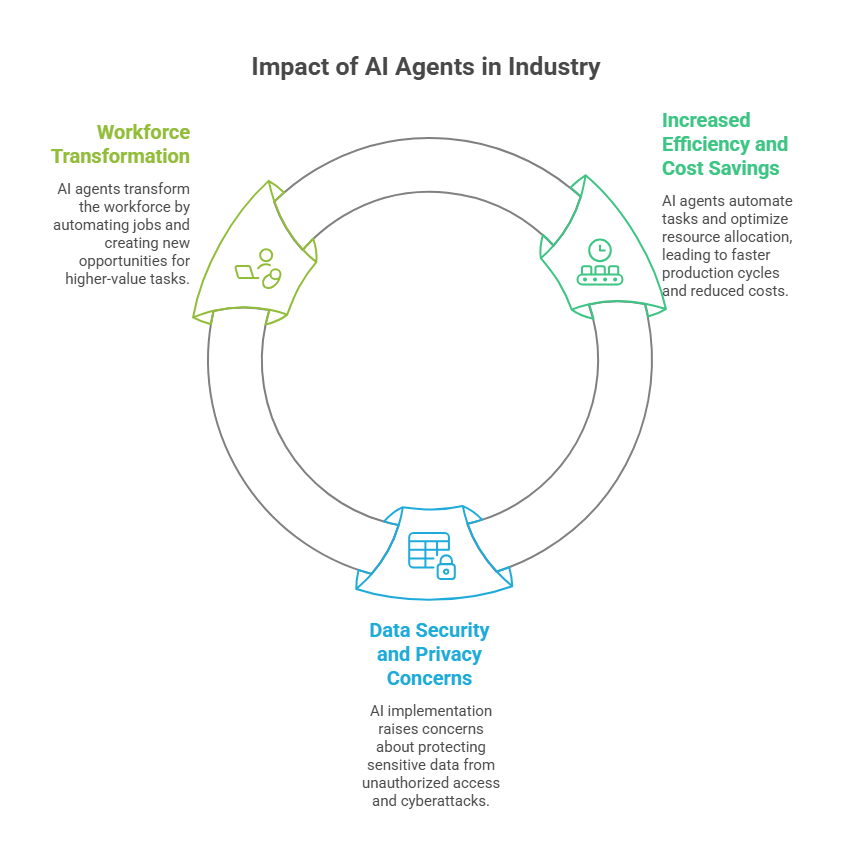
Future Trends in AI Agents for Industry
7.1 Emerging Technologies
The field of AI agents is rapidly evolving, with several emerging technologies poised to shape the future of manufacturing and logistics. One key trend is the increasing use of edge computing, which brings AI processing closer to the source of data. This reduces latency, improves real-time decision-making, and enhances data security by minimizing the need to transmit sensitive information to the cloud.
Another promising technology is federated learning, which allows AI agents to learn from decentralized data sources without sharing the raw data. This is particularly valuable in industrial settings where data may be distributed across multiple factories or supply chain partners.
Reinforcement learning is also gaining traction, enabling AI agents to learn through trial and error in complex, dynamic environments. This approach is well-suited for optimizing processes that are difficult to model analytically, such as robotic control or supply chain coordination.
7.2 The Road Ahead for Manufacturing and Logistics
Looking ahead, AI agents are expected to play an even more central role in manufacturing and logistics. As AI technology matures, we can anticipate more sophisticated applications, such as autonomous factories, self-optimizing supply chains, and personalized customer experiences.
The integration of AI agents with other advanced technologies, such as 5G, blockchain, and digital twins, will further accelerate innovation. 5G networks will provide the high-bandwidth, low-latency connectivity needed to support real-time AI applications. Blockchain can enhance supply chain transparency and security. Digital twins—virtual replicas of physical assets or processes—will enable AI agents to simulate and optimize operations in a risk-free environment.
The future of AI agents in industry is not just about automating tasks but about creating intelligent, adaptive systems that can continuously learn, improve, and drive sustainable growth.
Python Example: Simulating a Digital Twin for Predictive Maintenance
Below is a simplified Python example that simulates a digital twin monitoring a machine’s health and predicting maintenance needs.
python
import random
# Simulate a machine's digital twin
class MachineDigitalTwin:
def __init__(self, machine_id):
self.machine_id = machine_id
self.health_score = 100 # Initial health score
def simulate_operation(self):
# Simulate wear and tear
wear = random.uniform(0.1, 1.0)
self.health_score -= wear
if self.health_score < 0:
self.health_score = 0
def predict_maintenance(self):
# Simple prediction: if health score is low, recommend maintenance
if self.health_score < 30:
return "Recommend maintenance"
else:
return "No maintenance needed"
# Example usage
twin = MachineDigitalTwin("Machine001")
for i in range(50):
twin.simulate_operation()
print(f"Day {i+1}: Health score = {twin.health_score:.2f}, Recommendation = {twin.predict_maintenance()}")This example demonstrates how digital twins can be used to monitor and predict the health of industrial assets, supporting proactive maintenance strategies.
Conclusion
8.1 Key Takeaways
The integration of AI agents into manufacturing and logistics is fundamentally transforming the industrial landscape. These intelligent systems automate complex processes, optimize resource allocation, and enable real-time decision-making, leading to significant improvements in efficiency, cost savings, and product quality. From predictive maintenance and quality control in manufacturing to route optimization and supply chain management in logistics, AI agents are delivering tangible business value across the entire industrial value chain.
However, successful implementation requires more than just advanced technology. Companies must invest in high-quality data infrastructure, robust cybersecurity, and continuous employee training. Addressing challenges such as data privacy, system integration, and workforce transformation is essential to fully realize the benefits of AI agents.
8.2 How to Get Started with AI Agents in Your Business
For organizations looking to harness the power of AI agents, the journey should begin with a clear understanding of business objectives and pain points. Start with pilot projects in areas where AI can deliver quick wins, such as predictive maintenance or inventory optimization. Use these pilots to gather data, measure results, and refine your approach before scaling up.
Collaboration between IT, operations, and business teams is crucial for successful deployment. Invest in employee training to build digital skills and foster a culture of innovation. Partnering with technology providers or consulting experts can also accelerate adoption and help navigate technical challenges.
As AI technology continues to evolve, staying informed about emerging trends—such as edge computing, federated learning, and digital twins—will position your business to remain competitive and agile in a rapidly changing market.
Python Example: Simple Roadmap for AI Agent Implementation
Below is a basic Python script that outlines a step-by-step roadmap for implementing AI agents in an industrial setting. This can be used as a checklist or project plan template.
python
roadmap = [
"1. Identify business objectives and key challenges",
"2. Assess data availability and quality",
"3. Select a pilot project with clear ROI potential",
"4. Integrate AI agents with existing systems",
"5. Train employees and provide change management support",
"6. Monitor results and gather feedback",
"7. Refine the solution based on pilot outcomes",
"8. Scale up deployment across the organization",
"9. Stay updated on emerging AI trends and technologies"
]
print("AI Agent Implementation Roadmap:")
for step in roadmap:
print(step)This example provides a practical framework for organizations embarking on their AI journey, ensuring a structured and effective approach to adopting AI agents in industry.
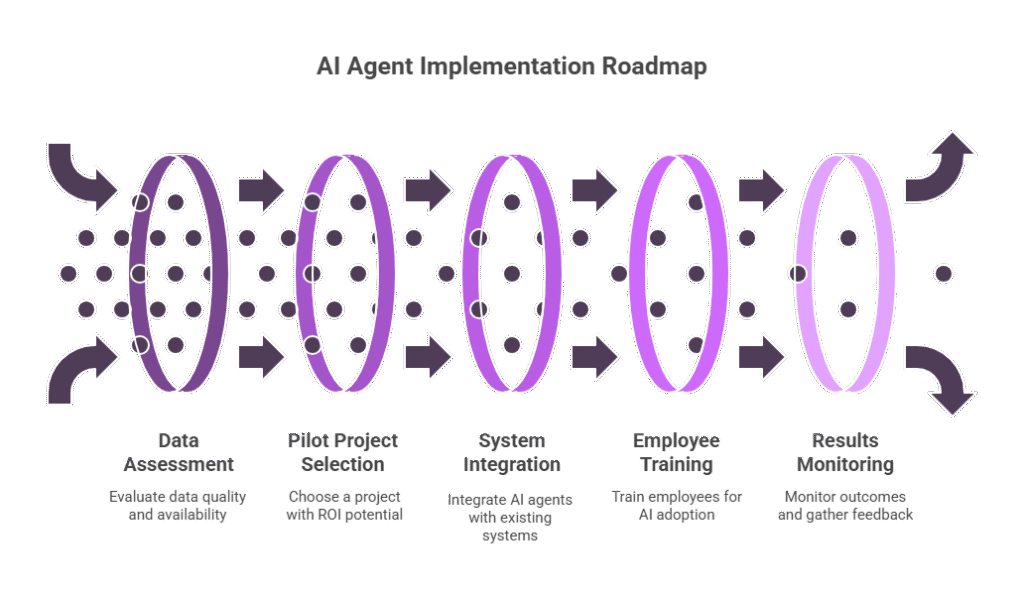
AI Agents in Practice: Automating a Programmer’s Daily Tasks
Human and AI: Agents as Creative Partners
Artificial Intelligence in Practice: How to Deploy AI Models in Real-World Projects
